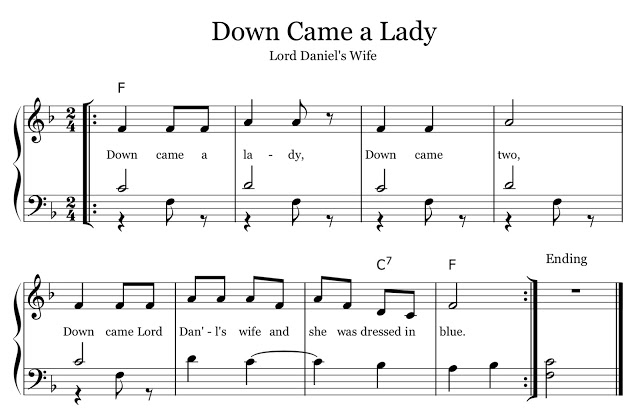
GAME
Students join hands and sing as they travel clockwise around in a circle. When the students sing “blue” the second time, the teacher points to someone wearing blue, and that student steps outside of the circle and walks counter-clockwise while the game continues. When students sing the song again, the person walking around on the outside, points to a student, and the rest of the students change the lyrics to match the chosen student. For example, “Down came Tommy and he was dressed in green.” Then, the chosen student joins the outer circle, and picks the next student, until everyone has joined the outer circle and is walking counter-clockwise.
RHYTHM
In the book, American Folk Songs For Children by Ruth Seeger, there are no half notes in this song. However, I have seen other versions which include a half note, and I prefer it that way. Because the half note occurs twice at the end of a phrase, it makes for a great teaching moment. Once students have played the game and are comfortable singing the song (without your help), ask them to identify the known rhythms (quarter and eighths). Then, discuss the rhythm they don’t know. Ask them how it’s different (longer or shorter). Once they’ve figured out that the new rhythm is two beats long, you can switch to some activities with instruments (including half note accompaniments).
INSTRUMENTS
Pull out your Orff instruments, handbells, or ukuleles to create an accompaniment. The chords are labeled in the notation above. With only one chord change, the students will be successful whether they’re playing a simple bordun or attempting a quick chord change on their ukulele. Create some more texture by adding a tambourine hit or egg shake on each upbeat.
I know that many of you are out for summer break, but I do hope you’ll continue to visit my blog and gather some ideas for the next school year. I truly appreciate hearing from all of you, and I love reading your thoughts and ideas. And for those who are on break, enjoy it! You deserve it!!

4 Responses
LOVE THIS! I've never heard it! Thank you very much. I think it might be a great Back to School song for k or 1st. Thank you so much. Love your blog.
Thank you Margaret!
This would be a great ice-breaker lesson for back to school. Thanks for sharing! #fermatafridays
Agreed! Thanks 🙂